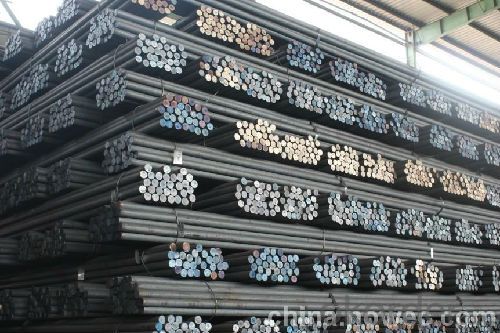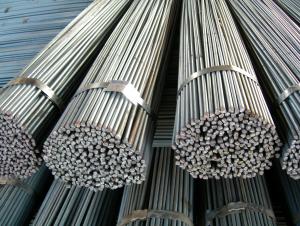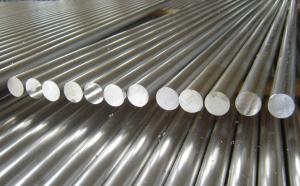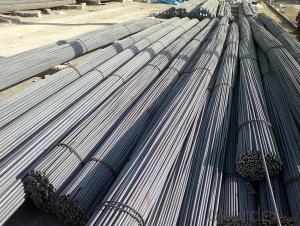Hot Rolled Steel Round Bar 40Cr
- Loading Port:
- China Main Port
- Payment Terms:
- TT or LC
- Min Order Qty:
- 100 m.t.
- Supply Capability:
- 2000 m.t./month
OKorder Service Pledge
OKorder Financial Service
You Might Also Like
Product Applications:
Hot Rolled Steel Round Bar are ideal for a large number of architectural and engineering structures. Or it can be used in construction of plants for the production of steel house frames, high-voltage transmission towers, bridges, vehicles, boilers, containers, ships, etc
Product Advantages:
OKorder's Hot Rolled Steel Round Bars are durable, strong, and with competitive price
Main Product Features:
· Premium quality
· Prompt delivery & seaworthy packing (30 days after receiving deposit)
· Corrosion resistance
· Can be recycled and reused
· Mill test certification
· Professional Service
· Competitive pricing
Product Specifications:
Manufacture: Hot rolled
Grade: Q195 – 235
Certificates: ISO, SGS, BV, CIQ
Length: 6m – 12m, as per customer request
Packaging: Export packing, nude packing, bundled
Diameter | Mass | Diameter | Mass | Diameter | Mass |
(mm) | (kg/m) | (mm) | (kg/m) | (mm) | (kg/m) |
6 | 0.22 | 22 | 2.98 | 53 | 17.30 |
7 | 0.30 | 24 | 3.55 | 56 | 19.30 |
8 | 0.40 | 25 | 3.85 | 60 | 22.20 |
9 | 0.50 | 26 | 4.17 | 63 | 24.50 |
10 | 0.62 | 28 | 4.83 | 65 | 26.00 |
11 | 0.75 | 30 | 5.55 | 70 | 30.20 |
12 | 0.89 | 32 | 6.31 | 75 | 34.70 |
13 | 1.04 | 34 | 7.13 | 80 | 39.50 |
14 | 1.21 | 36 | 7.99 | 85 | 44.50 |
15 | 1.39 | 38 | 8.90 | 90 | 49.90 |
16 | 1.58 | 40 | 9.86 | 95 | 55.60 |
17 | 1.78 | 42 | 10.90 | 100 | 61.70 |
18 | 2.00 | 45 | 12.50 | 120 | 88.85 |
19 | 2.23 | 48 | 14.20 | 140 | 120.93 |
20 | 2.47 | 50 | 15.40 | 150 | 138.82 |
FAQ:
Q1: Why buy Materials & Equipment from OKorder.com?
A1: All products offered byOKorder.com are carefully selected from China's most reliable manufacturing enterprises. Through its ISO certifications, OKorder.com adheres to the highest standards and a commitment to supply chain safety and customer satisfaction.
Q2: How do we guarantee the quality of our products?
A2: We have established an advanced quality management system which conducts strict quality tests at every step, from raw materials to the final product. At the same time, we provide extensive follow-up service assurances as required.
Q3: How soon can we receive the product after purchase?
A3: Within three days of placing an order, we will begin production. The specific shipping date is dependent upon international and government factors, but is typically 7 to 10 workdays.
Q4:What is the package
A4: Standard seaworthy packing or as customer required; all goods are packed in bundle with steel strips and shipped by break bulk vessel or container
Images:


- Q:What is the difference between a hot rolled and a turned steel round bar?
- The main difference between a hot rolled and a turned steel round bar lies in the manufacturing process and the resulting characteristics of the finished product. A hot rolled steel round bar is produced by heating a billet or ingot of steel to a high temperature and then rolling it into the desired shape. This process allows for the steel to be formed and shaped easily, resulting in a bar with a rough surface and a slightly rounded or irregular shape. Hot rolling also helps to improve the overall strength and toughness of the steel, making it suitable for a wide range of applications. On the other hand, a turned steel round bar is produced by machining a hot rolled or cold drawn bar on a lathe. This process involves removing material from the surface of the bar using cutting tools, resulting in a smooth and precise finish. Turning also allows for greater dimensional accuracy and control over the final shape and size of the bar. In terms of surface finish and dimensional accuracy, a turned steel round bar generally offers a higher level of precision compared to a hot rolled bar. The turned bar has a smoother surface with fewer imperfections, making it ideal for applications where appearance and aesthetics are important. Additionally, the turned bar typically has tighter tolerances, ensuring consistent dimensions throughout its length. The choice between a hot rolled and a turned steel round bar depends on the specific requirements of the application. Hot rolled bars are commonly used in construction, manufacturing, and general engineering applications where strength and toughness are crucial. Turned bars, on the other hand, are often used in industries such as automotive, aerospace, and precision machining, where a high level of surface finish and dimensional accuracy is required. In summary, the difference between a hot rolled and a turned steel round bar lies in the manufacturing process and the resulting characteristics. Hot rolled bars offer strength and toughness, while turned bars provide a smoother surface finish and greater dimensional accuracy. The choice depends on the specific needs of the application.
- Q:What are the different types of steel round bar surface treatments used in the automotive industry?
- In the automotive industry, there are several types of steel round bar surface treatments used to enhance the performance, durability, and aesthetics of the components. Some of the common surface treatments include: 1. Phosphating: Phosphating is a widely used surface treatment that involves applying a phosphate coating on the steel round bar. This treatment enhances corrosion resistance and provides a good base for further coatings or paints. 2. Galvanizing: Galvanizing involves applying a layer of zinc to the steel round bar's surface. This treatment provides excellent corrosion resistance and enhances the lifespan of the component. 3. Electroplating: Electroplating is a process where a thin layer of metal, such as chrome or nickel, is deposited onto the steel round bar's surface using an electric current. This treatment improves the appearance, provides corrosion resistance, and enhances wear resistance. 4. Powder coating: Powder coating is a popular surface treatment method where a dry powder is applied to the steel round bar's surface and then heated to form a protective coating. This treatment provides excellent durability, corrosion resistance, and can be customized with various colors and finishes. 5. Anodizing: Anodizing is typically used for aluminum components in the automotive industry. However, it can also be applied to steel round bars in certain cases. This treatment involves creating an oxide layer on the surface, providing improved corrosion resistance and enhancing the appearance. 6. Black oxide coating: Black oxide coating is a chemical treatment that creates a blackened surface on the steel round bar. This treatment provides corrosion resistance, improved aesthetics, and can also act as a lubricant in certain applications. It is important to note that the choice of surface treatment depends on the specific requirements of the automotive component, including environmental conditions, desired appearance, and functional properties. Manufacturers carefully select the appropriate treatment to ensure optimal performance and longevity of the steel round bar in the automotive industry.
- Q:How do you prevent scaling of steel round bars during heat treatment?
- To minimize scaling of steel round bars during heat treatment, various steps can be taken: 1. Employ a protective atmosphere: Heat treatment can be conducted in a controlled gas environment, such as a furnace with regulated gas composition. This shields the steel bars from oxygen exposure, the main cause of scaling. 2. Employ a protective coating: Coating the steel round bars with a substance like refractory material or a thin layer of paint can help prevent scaling. This creates a barrier between the steel and the oxygen in the atmosphere, reducing the likelihood of scaling. 3. Use a reducing atmosphere: Instead of a regular atmospheric environment, heat treatment can be carried out in a reducing atmosphere. This involves introducing gases like hydrogen or nitrogen into the furnace, reacting with oxygen to create a controlled environment that prevents scaling. 4. Control the heating rate: Rapid heating can lead to increased scaling due to sudden exposure to high temperatures. By controlling the heating rate, such as gradually increasing temperature, scaling can be minimized. 5. Limit the exposure time: Reducing the duration that steel round bars are exposed to high temperatures helps prevent scaling. This can be achieved by optimizing the heat treatment process and avoiding prolonged exposure to elevated temperatures. 6. Clean the surface before heat treatment: Before heat treatment, it is essential to remove any contaminants or residues from the surface of the steel round bars. This can be achieved through mechanical methods like wire brushing or chemical cleaning techniques, ensuring a clean surface that is less prone to scaling. Implementing these preventive measures effectively minimizes scaling of steel round bars during heat treatment, resulting in improved quality and performance of the treated bars.
- Q:What are the advantages of using carbon-manganese alloy steel round bars?
- Carbon-manganese alloy steel round bars offer numerous benefits: Firstly, they provide exceptional strength and durability, making them ideal for demanding applications. These bars can withstand heavy loads and resist deformation, ensuring long-lasting performance. Secondly, they possess excellent impact resistance, making them highly suitable for situations where there is a risk of impact or sudden loads. This feature helps to prevent fractures or breakages, enhancing safety and reliability. Furthermore, carbon-manganese alloy steel round bars have good weldability, allowing for easy fabrication and joining. They can be easily welded using common techniques, making them versatile and cost-effective for various construction projects. In addition, these bars exhibit good corrosion resistance, making them suitable for use in environments where exposure to moisture or corrosive substances is a concern. This property helps to extend the lifespan of the bars and reduces the need for frequent maintenance and replacement. Moreover, carbon-manganese alloy steel round bars are generally more cost-effective compared to other high-strength steel options. They offer a balance between strength and affordability, making them a cost-efficient choice for applications where high-strength materials are needed without excessive costs. Lastly, these bars are relatively easy to machine, allowing for precise shaping and finishing. This feature makes them suitable for applications that require complex or custom designs. Overall, the advantages of using carbon-manganese alloy steel round bars include their strength, durability, impact resistance, weldability, corrosion resistance, cost-effectiveness, and machinability. These properties make them a reliable and versatile choice for a wide range of applications in industries such as construction, automotive, and manufacturing.
- Q:What is the maximum vanadium content allowed for steel round bars?
- The maximum vanadium content allowed for steel round bars varies depending on the specific steel grade and industry standards. Vanadium is commonly used as an alloying element in steel to improve its strength, hardness, and resistance to corrosion. In general, the maximum vanadium content in steel round bars ranges from 0.02% to 0.25%. However, it is important to note that different steel grades and applications may have specific limits set by industry regulations or customer requirements. Therefore, it is crucial to consult the relevant standards and specifications for the specific steel grade and application to determine the maximum allowed vanadium content for steel round bars.
- Q:What are the different types of steel round bar coatings used in the marine industry?
- In the marine industry, various coatings are commonly used to protect steel round bars from corrosion and other environmental factors. These coatings have been specifically designed to withstand the harsh conditions found in marine environments. The most frequently utilized types of coatings in this industry include the following: 1. Galvanized Coating: A layer of zinc is applied to galvanized steel round bars, offering excellent corrosion protection and durability. This coating is ideal for marine applications where the steel is exposed to corrosive elements such as saltwater. 2. Epoxy Coating: Due to their exceptional resistance to corrosion and strong adhesion properties, epoxy coatings are widely employed in the marine industry. Multiple layers of epoxy are typically applied to ensure optimal protection against saltwater, chemicals, and abrasion. 3. Polyurethane Coating: Polyurethane coatings are highly regarded for their exceptional resistance to UV rays, chemicals, and abrasion. These coatings provide a high level of corrosion protection in marine environments, making them ideal for offshore structures and marine equipment that require long-term durability. 4. Organic Coatings: Acrylics and vinyls are commonly used in the marine industry as organic coatings, offering a protective barrier against corrosion and environmental factors. These coatings are known for their flexibility, ease of application, and resistance to UV radiation. They are often utilized in marine applications where aesthetics and color retention are important. 5. Ceramic Coating: Ceramic coatings are particularly resistant to high temperatures, chemicals, and abrasion. They form a hard, protective layer on steel round bars, making them suitable for marine applications that involve extreme heat and harsh environments. When selecting the appropriate steel round bar coating for a marine project, it is essential to consider the specific requirements of the application. Factors such as the type of exposure, expected service life, and budget should be taken into account to determine the most suitable coating.
- Q:What is the maximum nitrogen content allowed for steel round bars?
- The maximum nitrogen content allowed for steel round bars varies depending on the specific steel grade and application requirements. However, in general, the nitrogen content is typically limited to around 0.025-0.035% to maintain the desired mechanical properties and avoid detrimental effects on the material's performance.
- Q:What are the common sizes and dimensions of steel round bars?
- Steel round bars come in a variety of sizes and dimensions to cater to different applications and requirements. The most common sizes and dimensions of steel round bars include diameters ranging from 1/4 inch to 24 inches. These diameters correspond to the nominal size of the round bar, which represents the approximate measurement of the bar's cross-sectional diameter. In terms of dimensions, steel round bars are typically available in standard lengths of 20 feet or 6 meters. However, custom lengths can be produced upon request. The length of the round bar is crucial as it determines the amount of material available for cutting, shaping, and fabrication. Additionally, the weight of steel round bars can vary depending on their size. Steel is typically measured by its weight per unit length, commonly expressed in pounds per foot or kilograms per meter. The weight of a steel round bar is influenced by the diameter, length, and specific type of steel used. It is worth noting that the sizes and dimensions mentioned above are standard in the industry, but there may be variations depending on the specific manufacturer or supplier. Therefore, it is always advisable to consult the manufacturer's catalog or contact them directly to obtain accurate and up-to-date information on the sizes and dimensions of steel round bars they offer.
- Q:Can steel round bars be used in the production of packaging equipment?
- Steel round bars are indeed a versatile option for the production of packaging equipment. Their exceptional strength and durability make them highly favored in various industries. When it comes to packaging equipment, these round bars serve multiple purposes, such as offering structural support, reinforcement, or acting as components in the machinery's moving parts. The steel's impressive hardness and resistance to wear and tear make it ideal for handling heavy loads and ensuring uninterrupted operation. Moreover, steel round bars can be easily machined, welded, or modified to precisely meet the specific requirements of the packaging equipment. All in all, steel round bars are a dependable and widely utilized material in the manufacturing of packaging equipment.
- Q:Are steel round bars suitable for welding?
- Yes, steel round bars are suitable for welding. Steel round bars are commonly used in welding applications due to their excellent strength and durability. They can be easily welded using various welding techniques such as MIG (Metal Inert Gas), TIG (Tungsten Inert Gas), or stick welding. However, it is important to choose the appropriate welding method and consumables based on the specific grade and alloy composition of the steel round bar to ensure a successful weld. Additionally, proper surface preparation and cleaning are crucial to achieve strong and reliable welds. Overall, steel round bars are a popular choice for welding projects due to their versatility and ability to withstand high temperatures and stress.
1. Manufacturer Overview |
|
|---|---|
| Location | |
| Year Established | |
| Annual Output Value | |
| Main Markets | |
| Company Certifications | |
2. Manufacturer Certificates |
|
|---|---|
| a) Certification Name | |
| Range | |
| Reference | |
| Validity Period | |
3. Manufacturer Capability |
|
|---|---|
| a)Trade Capacity | |
| Nearest Port | |
| Export Percentage | |
| No.of Employees in Trade Department | |
| Language Spoken: | |
| b)Factory Information | |
| Factory Size: | |
| No. of Production Lines | |
| Contract Manufacturing | |
| Product Price Range | |
Send your message to us
Hot Rolled Steel Round Bar 40Cr
- Loading Port:
- China Main Port
- Payment Terms:
- TT or LC
- Min Order Qty:
- 100 m.t.
- Supply Capability:
- 2000 m.t./month
OKorder Service Pledge
OKorder Financial Service
Similar products
New products
Hot products
Related keywords































